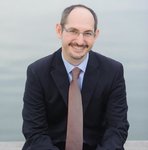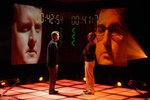Cloudy, 72°
Wind: mph,



Severna Park native Ogi Ogas once won $500,000 on the game show “Who Wants to Be a Millionaire?” and he also appeared on “Grand Slam,” “500 Questions” and “Jeopardy!” — but it’s the money he didn’t win that burdens him with regret.
“I completely botched my appearance on that show,” Ogas said of “Who Wants to Be a Millionaire?” even though he was one question from securing $1 million in 2006, when he was a 35-year-old doctoral candidate. “I know I did well. I prepared monstrously for that show, and when I was there in studio, the pressure got to me.”
Perfectionism may be one of Ogas’ predominate traits, but he didn’t acquire it while sitting opposite “Millionaire” host Meredith Vieira; he has fostered the same attitude since adolescence.
"It's Academic"
The son of Sandy Ogas, a former Severna Park High School nurse, Ogi Ogas doesn’t remember why he joined the “It’s Academic” team at Severna Park High School, but he does recall scoring highly on a 50-question test to earn a spot on the team. “Right away, I took it very seriously,” he said, recounting how the team twice made it to the championship while winning once during his tenure.
“I was terrible at pop culture – TV shows, and back then, I didn’t know sports trivia,” he said. “‘It’s Academic’ by its very nature is very little pop culture questions, at least when I played.”
A year after graduating from Severna Park High School, Ogas appeared on “Jeopardy!” A decade later, he would return to the limelight, taking a new approach to trivia by using his background as a computational neuroscientist, a profession that views the brain as software.
Stuffy head or persistent cough?
For his appearance on “Who Wants to Be A Millionaire?” Ogas took a series of calculated risks and relied on cognitive techniques that he learned at the University of Boston. While preparing, he also drank innumerable cups of coffee to simulate the anxiety he would feel during the competition.
Ogas rolled along until the final few questions. For the $500,000 question, he was asked, “In the 1980s, heroin was introduced commercially to the U.S. by Bayer as a remedy for what ailment?”
After using his 50-50 lifeline to eliminate “stiff joints” and “high fever,” remaining options were “stuffy head” and “persistent cough.” Ogas’ correct answer? Persistent cough.
Then, with $1 million on the line, he was asked, “Which of these ships was not one of the three taken over by colonists during the Boston Tea Party?” With the options of Eleanor, Dartmouth, Beaver and William, Ogas opted to keep his winnings, even though he had a hunch that the answer was “William.” Had he answered incorrectly, he would have been left with $25,000. The answer was “William.”
“I really thought I was going to win the million. It wasn’t overconfident speculation,” he said. Kicking himself for not going for it all, he said, “I was married at the time. I think if I had been single, I would have gone for it. But I kept thinking that if I got it wrong, my wife would have killed me.”
A stare-down on “Grand Slam”
That performance led to an invitation on “Grand Slam” one year later. A single-elimination tournament with rapid-fire questions and timed responses, “Grand Slam” pitted 16 of the biggest winners in U.S. game show history against one another. After defeating “Who Wants to Be a Millionaire?” winner Nancy Christy in the opening round, Ogas upset Brad Rutter, who holds records as both the highest-earning winner on “Jeopardy!” and highest-earning game show contestant of all time. From there, Ogas ousted David Legler of “Twenty One” fame. For the final round, Ogas faced Ken Jennings, who had won 74 consecutive “Jeopardy!” matches.
Ogas and Jennings started each of the five rounds with one minute on the clock. Any leftover time maintained by the winner of each round was added to that player’s time for the fifth and final round.
The computational neuroscientist from Severna Park had a 14-second lead at the end of the first round (general knowledge) and a 2.96-second margin from the second round (numbers and logic), but Jennings picked up 48.64 seconds in the third round (contemporary knowledge), and Ogas couldn’t rebound. Still, Jennings was impressed by his opponent.
“The first two rounds were very close, but I was surprised by how legit he was on the trivia stuff,” Jennings said. “The thing that impressed me wasn't the math — it was when he knew immediately that the first woman to serve in the Senate was from Georgia. That's a genuinely hard question. Over 90 percent of ‘Jeopardy!’ players get that wrong, I think. At that point, I was worried.”
But as the match went on, Jennings took control. “I should also say that the match was much closer than the score looked, because Ogi got some bad breaks (I got no anagram questions in round four; he got three) and it kind of took the wind out of his sails. He seemed like a different player in the final round than the guy in the first two.”
Ogas blamed his performance on circadian rhythms, or the body’s cycle of sleeping and eating. Producers told contestants they would tape the show at noon, and Ogas timed his sleep accordingly, waking up around 6:00am and going to bed around 10:00pm so that his brain activity would peak at noon. However, due to a scheduling conflict with host Dennis Miller, the final round was taped around midnight.
Because the show had a winner-take-all format, Ogas walked away empty-handed, but he did receive plenty of scorn from fellow contestants for his celebratory fist pumps, aversion to backstage conversation and for saying that Rutter “does math like a little girl.”
“I was there to win and I went in with a competitive mindset,” Ogas reflected. “With very few exceptions, [the contestants] were there for fun. … I really wanted to pay for my mortgage and student loans, even more than I wanted the glory of the title.”
“A Billion Wicked Thoughts”
Following his game-show run, Ogas and classmate Sai Gaddam co-authored “A Billion Wicked Thoughts,” which explored the catalysts of human desire.
“We were told that it was a career killer, that it was too taboo,” Ogas said of the book. “They said to stick with the higher functions of the brain, like language or memory. [Sexuality is] so political, academics stay away from it.”
Gaddam was not only a co-author and Ogas’ peer from Boston University but he was also Ogas’ phone-a-friend lifeline on “Who Wants to Be a Millionaire?”
“It's rare that first-time authors get multiple publishing houses bidding for a manuscript. It was Ogi's hard work and charisma that made it happen,” Gaddam said. “As for the actual process of working on the book, I couldn't have asked for a better partner. It remains my most intense, productive and life-changing collaboration. Ogi's unwavering belief in what we were doing helped me push myself.”
After “A Billion Wicked Thoughts,” Ogas co-authored “Shrinks: The Untold Story of Psychiatry” with Jeffrey Lieberman and he collaborated with Todd Rose on “The End of Average.”
Dark Horse and “500 Questions”
At the Harvard Graduate School of Education, Ogas now leads the Dark Horse Project, which will be the focus of his next book.
“We’re studying people who become successful by taking unorthodox routes to achievement,” Ogas said. “One example in the book is a woman who dropped out of high school at 15 and was working at a fast-food restaurant at 21, and she is now an internationally respected astronomer.”
Now that he’s working on another book, Ogas said he is done with game shows, even though he appeared on yet another contest, “500 Questions,” in 2015.
“I’ve got a bad memory, which is partly why I went to study memory,” he said. “I’m not good at trivia and I’m not particularly interested in trivia. Game shows require so many hours of preparation and that’s time I could be spending on my book.”
Gaddam expects Ogas to continue surprising people, whether he’s on TV or not. “He's easily the smartest guy I've known,” Gaddam said. “But what makes him a potent force in pretty much anything he takes up is the intensity and commitment with which he takes up a task and constantly chips away at it. His ability to analyze, understand and break down complex undertakings is astonishing. Learning from him is also a bit like trying to learn how to run from Usain Bolt. You can admire his talents, but can you really learn them through observation and proximity?”
Comments
No comments on this item Please log in to comment by clicking here